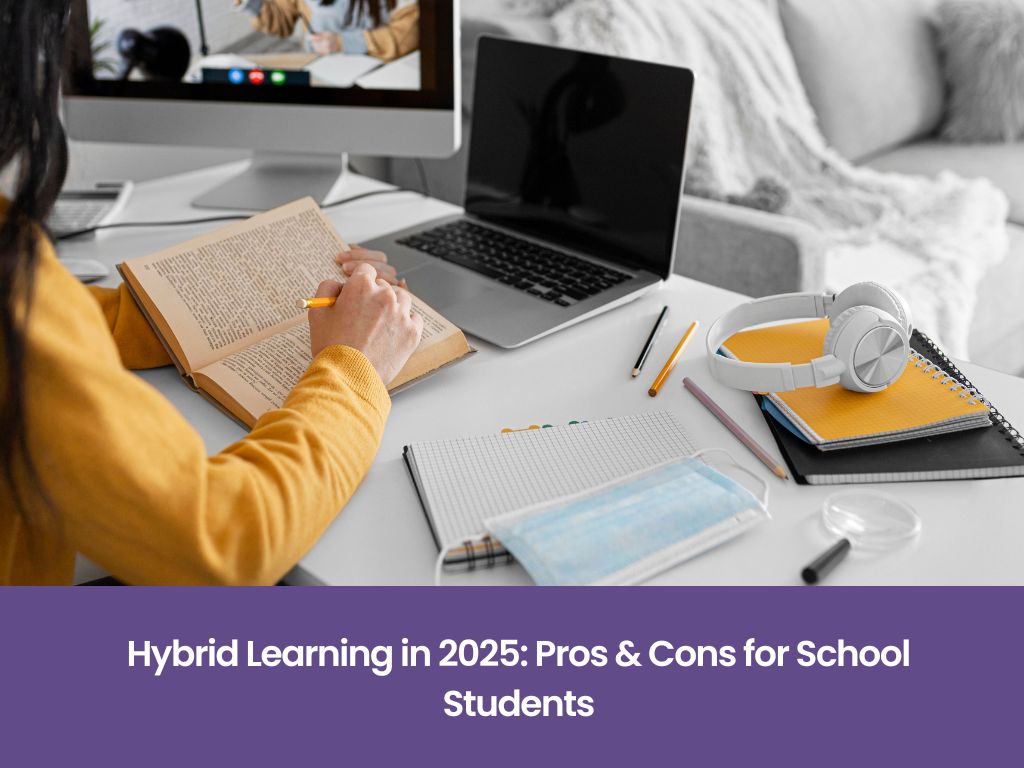Hybrid Learning in 2025: Pros & Cons for School Students
posted on Jun 06, 2025
Explore the pros and cons of hybrid learning in 2025. Learn how top schools like Bgs Vijnatham are adopting this flexible and future-ready model.

Introduction
The education landscape is undergoing a massive transformation, with hybrid learning emerging as one of the most revolutionary developments in recent years. The global pandemic was a catalyst, but even beyond it, schools and institutions are recognizing the long-term benefits of combining traditional classroom learning with digital platforms. As we step into 2025, hybrid learning is no longer an alternative — it’s a necessity. Institutions like Bgs Vijnatham, one of the best schools in Noida Extension, are leading this shift by implementing well-structured hybrid learning environments that focus on flexibility, engagement, and innovation.
What is Hybrid Learning?
Hybrid learning, often referred to as blended learning, is an educational approach that combines physical, face-to-face teaching with virtual learning experiences. It allows students to attend a portion of their classes online, giving them the freedom to access course content, complete assignments, and interact with teachers outside traditional classroom hours. This model promotes self-paced learning while maintaining the structure of in-person interactions.
Benefits of Hybrid Learning
1. Flexibility and Convenience
Students benefit immensely from the flexibility that hybrid learning offers. It allows them to revisit lectures, access materials any time, and balance academics with extracurricular or personal responsibilities. This flexibility is particularly useful in reducing student burnout and promoting a healthier study-life balance.
2. Personalized Learning Experience
Every student learns differently. Hybrid models make it easier for educators to customize learning experiences based on student needs. With the help of digital tools and analytics, teachers can monitor progress and provide individualized support, thereby improving learning outcomes.
3. Enhanced Technological Skills
Students become more adept with technology through hybrid learning. They learn to use learning management systems, video conferencing tools, collaborative apps, and digital research resources — skills that are essential in the modern workforce.
4. Increased Student Engagement
Gamified learning content, interactive videos, live discussions, and virtual simulations can make lessons more engaging than traditional methods alone. The hybrid model taps into diverse learning styles, keeping students more actively involved.
5. Resilience to Disruptions
Whether it's due to health issues, travel, or emergencies, hybrid learning offers continuity. Schools that implement this model can pivot smoothly to online learning without interrupting academic progress.
Challenges of Hybrid Learning
1. Digital Divide
One of the major drawbacks of hybrid learning is the inequality in access to technology. Not all students have reliable internet or access to devices at home, which can widen the educational gap. Schools need to ensure equitable access for hybrid models to succeed.
2. Need for Strong Self-Motivation
Unlike traditional settings where a teacher supervises every step, hybrid learning demands high levels of self-discipline. Students who lack motivation or time management skills may struggle with the autonomy the model requires.
3. Teacher Readiness
For hybrid learning to work, teachers need to be trained not just in digital tools but also in instructional design for online environments. The shift can be overwhelming if adequate support and time for training are not provided.
4. Reduced Peer Interaction
Face-to-face interactions play a crucial role in social development. In hybrid settings, opportunities for casual peer interactions may be limited, potentially affecting students’ collaborative and interpersonal skills.
5. Assessment and Evaluation Complexities
Assessing student performance in a hybrid model poses unique challenges. Ensuring academic integrity, creating balanced assessments, and measuring outcomes across online and offline formats can be complex for educators.
Hybrid Learning in Indian Schools
In India, the adoption of hybrid learning has seen remarkable growth since 2020. With the support of government initiatives and increasing digital literacy, schools are now better equipped to implement hybrid models. However, the journey is far from over. The success of hybrid learning depends on long-term planning, infrastructure investment, and an inclusive approach that considers students from all socioeconomic backgrounds.
Progressive institutions like Bgs Vijnatham, one of the best school in Noida Extension, are setting benchmarks in this space. Their hybrid learning strategy includes smart classrooms, integrated learning management systems, and teacher development programs that ensure every student receives quality education, regardless of location or learning style.
The Way Forward
Hybrid learning is not just a temporary solution; it is a long-term strategy that aligns with the needs of 21st-century learners. While it comes with its set of challenges, the advantages far outweigh the disadvantages when implemented effectively. Schools must focus on inclusive practices, continuous teacher training, and technological investments to make hybrid learning accessible and impactful.
Conclusion
The rise of hybrid learning marks a pivotal moment in education. It has opened doors to new methods of teaching and learning, breaking down the limitations of the traditional classroom. As we move further into the digital age, hybrid learning will play a crucial role in shaping well-rounded, future-ready students.